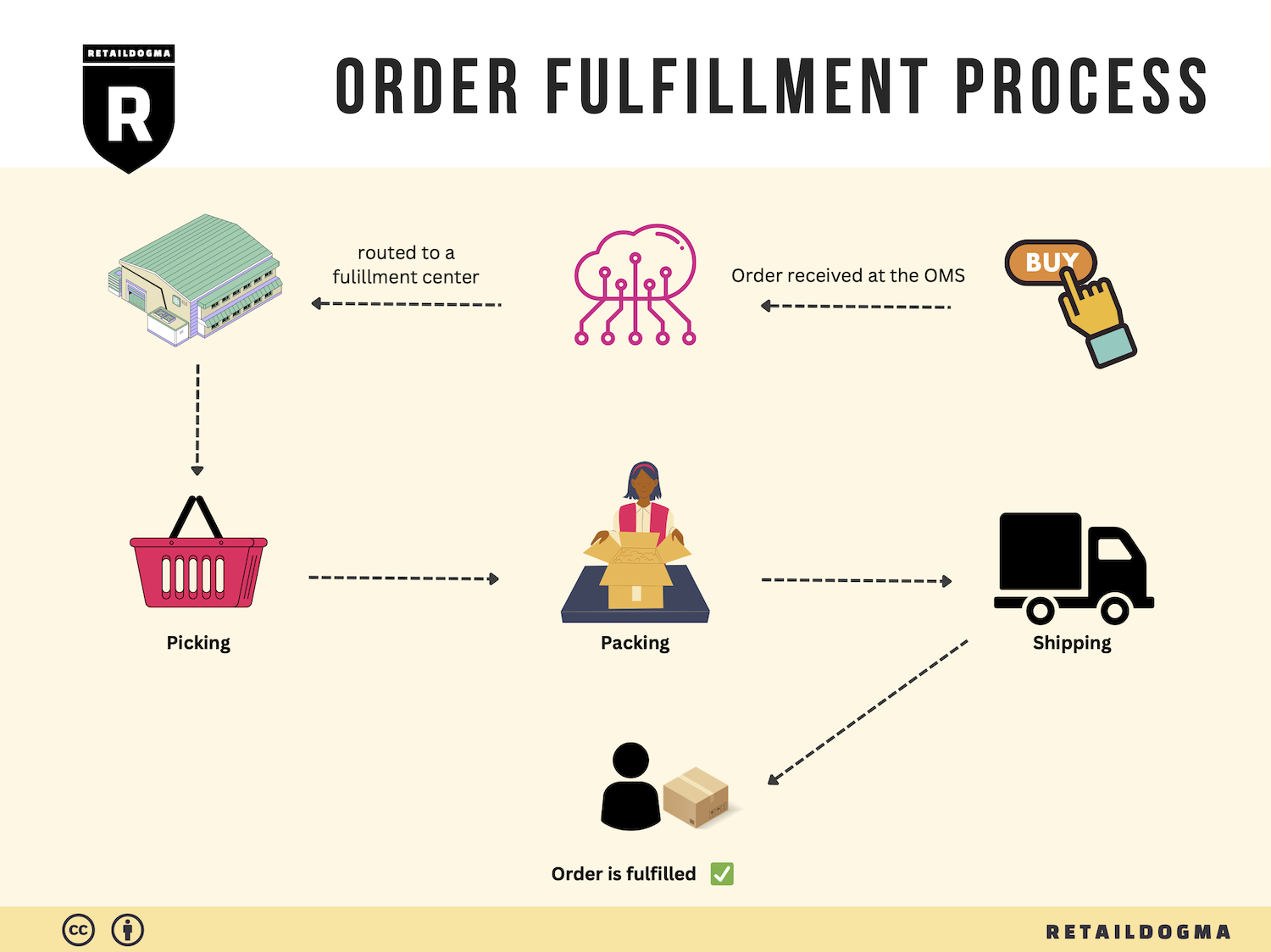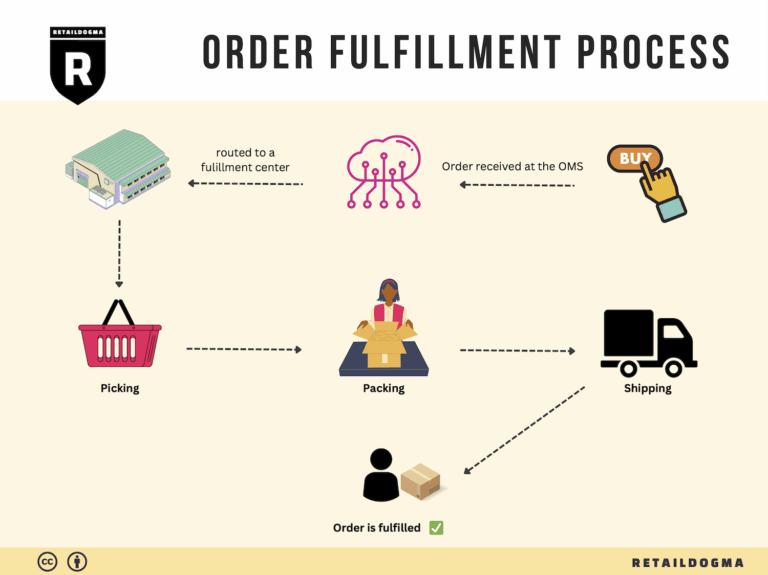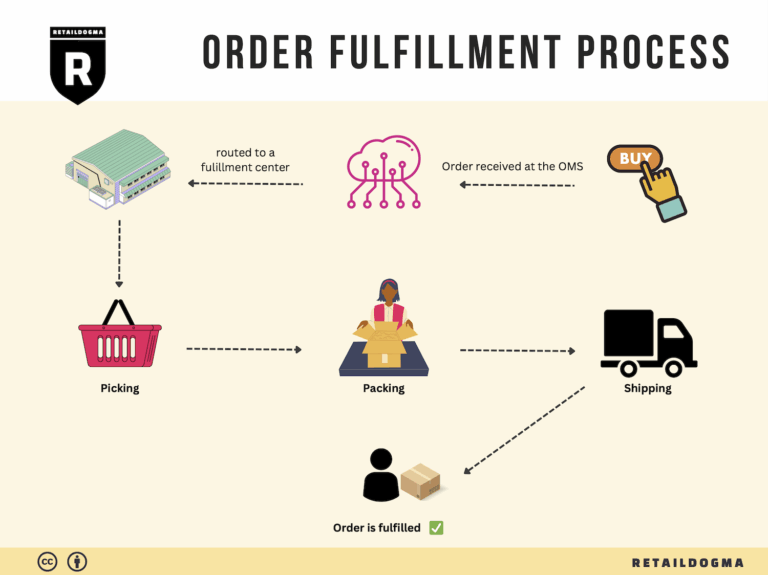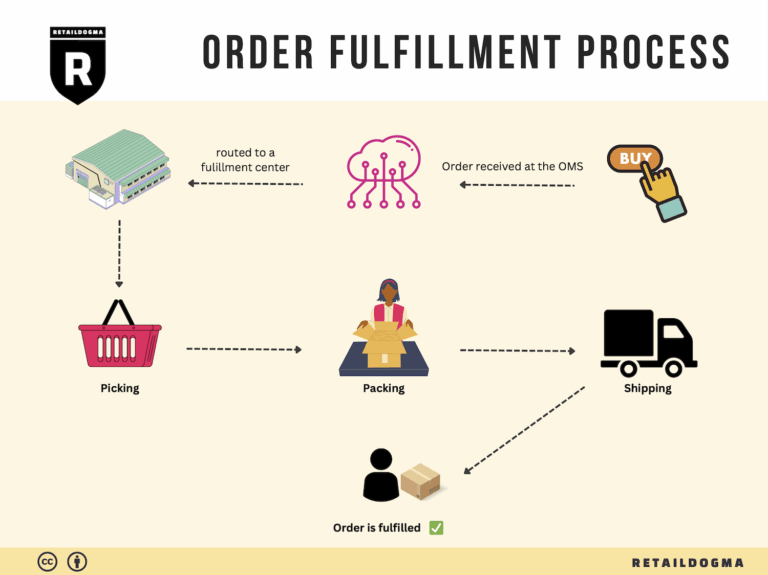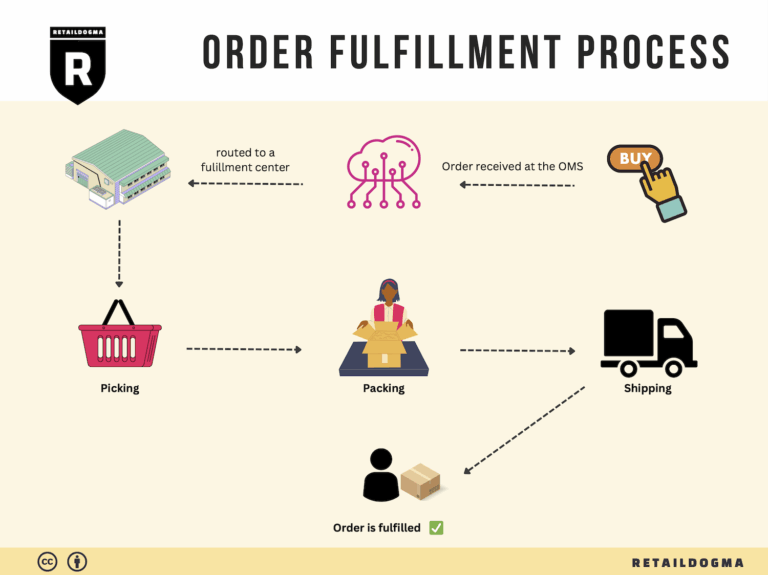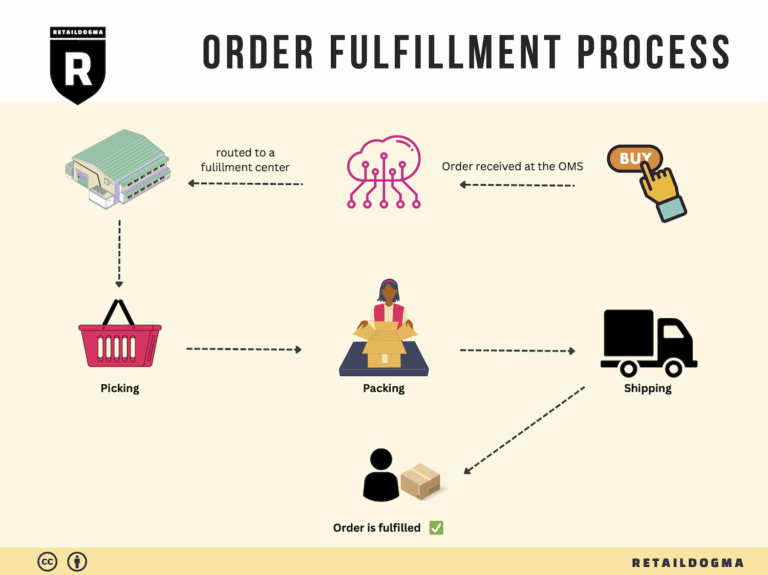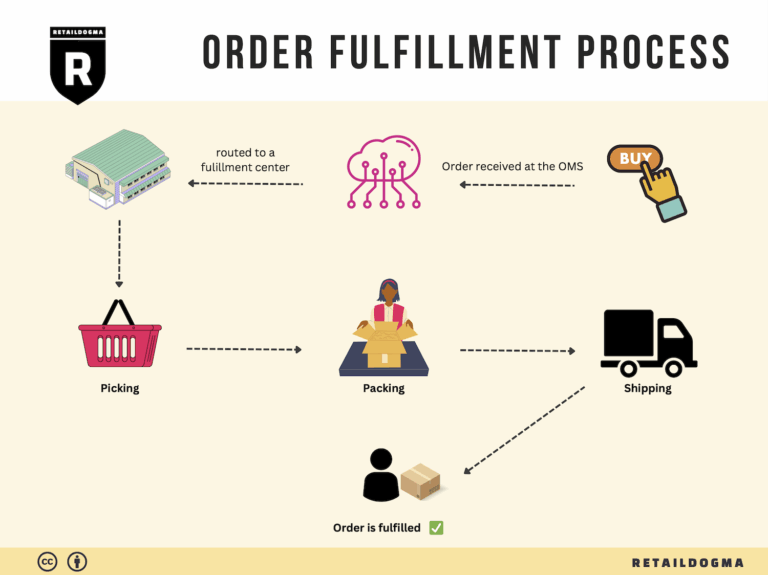What Is A Fulfillment Center? A Complete Guide (2025)
What is E-commerce Fulfillment? An Introduction for Growing Businesses
Understanding E-commerce Fulfillment: A Key to Scaling Your Business
As a growing e-commerce business, you may find yourself overwhelmed with the logistics of packing and shipping orders. Managing inventory, ensuring timely deliveries, and maintaining customer satisfaction can quickly become a daunting task. This is where e-commerce fulfillment comes into play. Simply put, fulfillment is the process of getting a product from your inventory to your customer’s doorstep. It encompasses everything from receiving and storing products to picking, packing, and shipping orders.
In this guide, we will explore the various facets of e-commerce fulfillment to help you navigate this crucial aspect of your business. We’ll delve into different fulfillment models, such as third-party logistics (3PL) and Fulfillment by Amazon (FBA), outlining their unique benefits and challenges. Understanding these options can empower you to choose the right model that aligns with your business needs and growth ambitions.
We will also cover the core services offered by fulfillment partners, including inventory management, order processing, and customer support. Knowing what services to expect can help you evaluate potential partners and ensure they can meet your requirements effectively. Additionally, we will provide insights on how to select the right fulfillment partner, considering factors such as location, technology integration, and service level agreements.
Pricing is another critical element that we will address. Fulfillment costs can vary significantly based on the services provided, the volume of orders, and the type of products being shipped. We’ll break down the various pricing structures and help you understand how to budget for these expenses as you scale.
Ultimately, this guide aims to empower you to make informed decisions about your logistics strategy. By understanding the intricacies of e-commerce fulfillment, you can streamline your operations, reduce overhead costs, and enhance the customer experience. With the right fulfillment approach, you’ll not only alleviate the stress of logistics but also position your business for sustainable growth in the competitive e-commerce landscape.
What You’ll Learn In This Guide
- What is E-commerce Fulfillment? An Introduction for Growing Businesses
- The Order Fulfillment Process: From ‘Buy’ Button to Customer’s Door
- Comparing Fulfillment Models: In-House vs. 3PL vs. Dropshipping
- A Deep Dive into Amazon FBA: Pros, Cons, and Who It’s For
- Core Services Offered by Fulfillment Centers
- How to Choose a Fulfillment Partner: A 6-Point Checklist
- Understanding Fulfillment Pricing: A Breakdown of Common Fees
- Frequently Asked Questions (FAQs) about Fulfillment
- Conclusion: Is Outsourcing Fulfillment the Right Move for Your Business?
- Important Disclaimer
The Order Fulfillment Process: From ‘Buy’ Button to Customer’s Door
1. Receiving Inventory
The first step in the order fulfillment process is receiving inventory. When products arrive at the fulfillment center, they are unloaded from delivery vehicles and checked for accuracy against shipping documents. This step is crucial as it ensures that the right products in the correct quantities are received. Each item is assigned a Stock Keeping Unit (SKU), a unique identifier that helps track inventory throughout the supply chain.
This process involves careful inspection to identify any damages or discrepancies, which can significantly impact customer satisfaction if left unaddressed. Efficient receiving practices not only streamline the inventory process but also minimize errors that could lead to fulfillment delays. By leveraging technology, such as barcode scanning systems, businesses can automate the data entry process, reducing manual errors and speeding up the overall receiving time.
2. Warehouse Storage
Once inventory is received and verified, it is then moved to designated storage areas within the fulfillment center. This step involves stowing items in a manner that optimizes space and facilitates easy retrieval. The organization of the warehouse is pivotal; items can be categorized by various criteria such as size, weight, or product type.
Proper warehouse storage plays a significant role in reducing picking times later in the fulfillment process. For instance, fast-moving items might be stored closer to the picking stations to enhance efficiency. Implementing a robust Warehouse Management System (WMS) can further optimize storage solutions by utilizing algorithms that determine the most efficient placement of goods. This not only enhances operational efficiency but also supports scalability as businesses grow.
3. Order Picking
Order picking is the process where items are selected from the warehouse to fulfill customer orders. When a customer clicks the ‘Buy’ button, the order is automatically sent to the fulfillment center, generating a pick list. This list outlines the specific items and quantities needed to complete the order.
Efficient picking is crucial for maintaining a fast order turnaround time. At Amazon fulfillment centers, advanced technologies like robotics and automated systems are employed to streamline this process. For example, robots may transport storage pods to pick stations, where human associates retrieve the required items. This hybrid approach not only speeds up the picking process but also reduces human error, ensuring that customers receive the correct products.
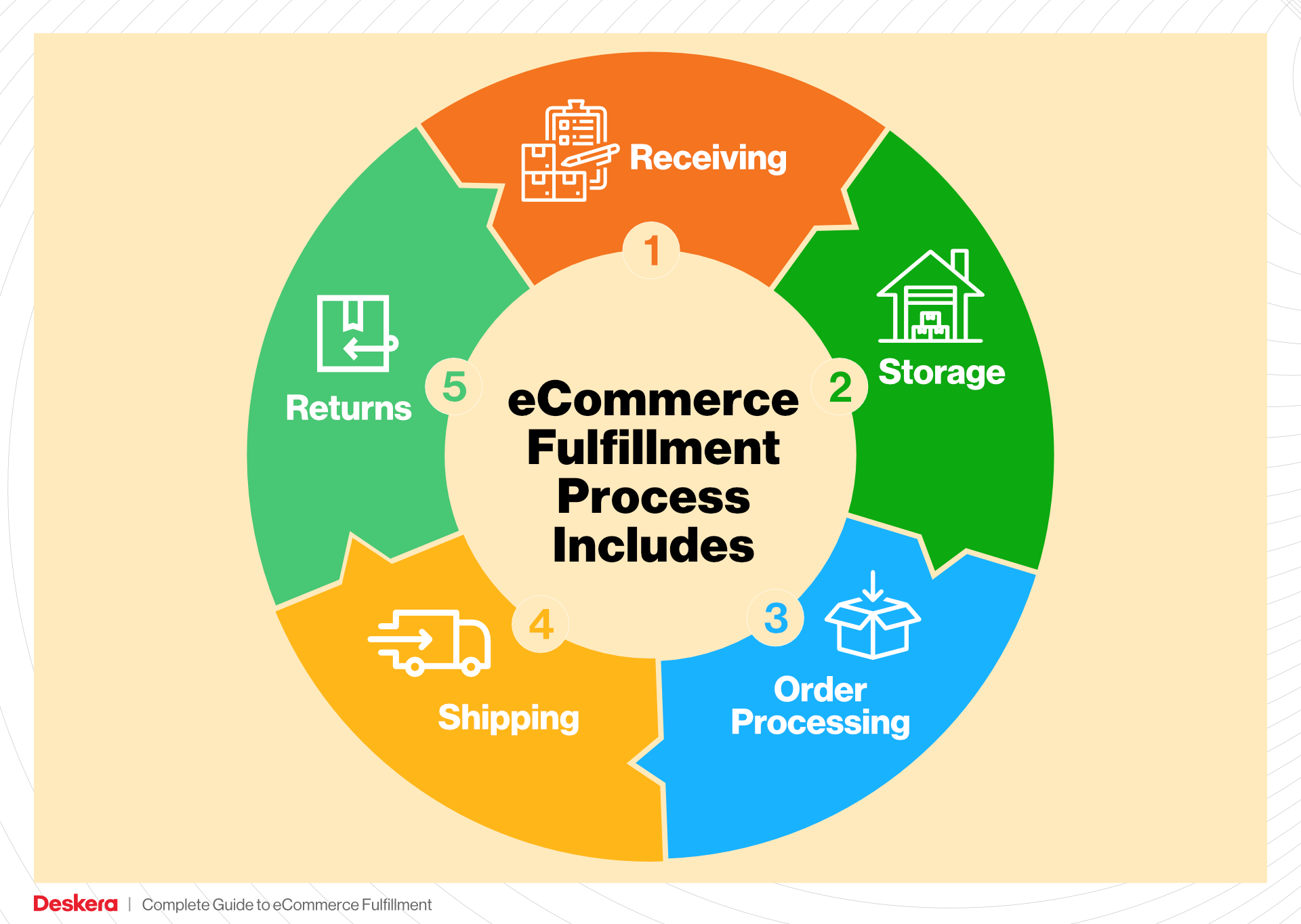
4. Order Packing
After items are picked, they proceed to the packing stage. Here, associates carefully package the products to prepare them for shipping. This step involves selecting the appropriate box size, ensuring items are securely packed, and applying necessary protective materials to prevent damage during transit.
The packing process is vital for maintaining product integrity and ensuring customer satisfaction. A well-packed order can reduce return rates and enhance the overall customer experience. Advanced packing systems can recommend box sizes and calculate the optimal amount of packing materials, minimizing waste and costs. This step is also where shipping labels are generated, which is essential for tracking packages throughout the delivery process.
5. Shipping & Delivery
The final step in the order fulfillment process is shipping and delivery. Once packed, orders are weighed, labeled, and sorted based on their destination and shipping method. This is where the efficiency of a fulfillment center shines, as packages are quickly routed to the appropriate transportation methods—be it Amazon’s delivery vans, planes, or third-party carriers.
Effective shipping strategies are crucial for meeting customer expectations, especially in an era where rapid delivery is the norm. Understanding the nuances of shipping options, such as expedited shipping for Prime members, can significantly enhance customer satisfaction. Additionally, tracking systems allow both businesses and customers to monitor the status of their orders, fostering transparency and trust. By leveraging a diversified delivery fleet, businesses can ensure timely and cost-effective delivery, which is essential for scaling operations and maintaining a competitive edge in the e-commerce landscape.
In conclusion, each step in the order fulfillment process is interconnected, and optimizing them can lead to increased efficiency, reduced costs, and enhanced customer satisfaction. By understanding and implementing best practices at each stage, e-commerce businesses can effectively scale their operations and improve their bottom line.
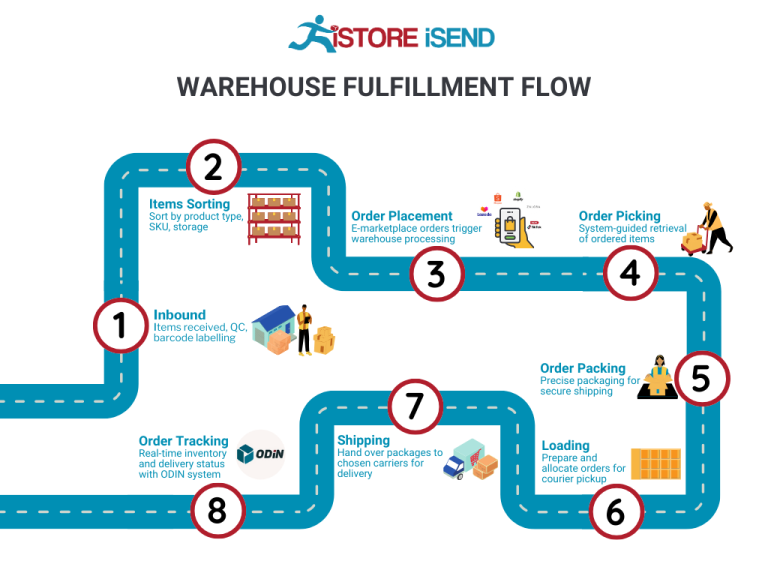
Comparing Fulfillment Models: In-House vs. 3PL vs. Dropshipping
Fulfillment Model Comparison
| Model | Who Handles Inventory | Best For (Business Stage) | Key Advantage | Key Disadvantage |
|---|---|---|---|---|
| In-House Fulfillment | The business itself | Established businesses with stable sales | Full control over inventory and processes | High overhead costs and resource requirements |
| Third-Party Logistics (3PL) | A third-party logistics provider | Growing businesses looking to scale | Scalability and expertise in logistics | Less control over fulfillment processes |
| Dropshipping | Suppliers or manufacturers | Startups or businesses testing new products | Low startup costs and no inventory risk | Lower profit margins and potential quality issues |
In-House Fulfillment
In-house fulfillment refers to a model where the e-commerce business manages its own inventory and order fulfillment processes. This typically involves receiving inventory, storing it, picking and packing orders, and shipping them directly to customers. Established businesses with stable sales often opt for this model as it allows for greater control over the entire fulfillment process. The key advantage of in-house fulfillment is the ability to maintain strict quality control and customize the fulfillment process to align with brand standards. However, it comes with significant disadvantages, including high overhead costs associated with staffing, warehousing, and maintaining logistics infrastructure. Businesses must also invest in technology and systems to manage inventory and orders effectively, which can be resource-intensive and may divert focus from core business operations.
Third-Party Logistics (3PL)
Third-party logistics (3PL) involves outsourcing logistics and fulfillment operations to specialized providers who manage inventory and shipping on behalf of the business. This model is particularly advantageous for growing businesses looking to scale their operations without the burden of managing logistics in-house. The key advantage of using 3PL is the scalability it offers; businesses can easily adjust their logistics needs based on demand fluctuations without incurring the fixed costs associated with owning fulfillment facilities. Additionally, 3PL providers often bring expertise in logistics, allowing businesses to benefit from optimized shipping rates and advanced technology. However, a notable disadvantage is the loss of control over the fulfillment process, which can lead to inconsistencies in service quality. Businesses must choose their 3PL partners carefully to ensure alignment with their operational standards and customer service expectations.
Dropshipping
Dropshipping is a fulfillment model where the business sells products without holding any inventory. Instead, when a customer places an order, the business purchases the item from a third-party supplier, who then ships it directly to the customer. This model is particularly appealing for startups or businesses testing new products due to its low startup costs and minimal risk, as there’s no need to invest in inventory upfront. The key advantage of dropshipping is the flexibility it offers; businesses can quickly adapt their product offerings based on market demand without the financial commitment of maintaining inventory. However, dropshipping comes with significant disadvantages, including lower profit margins due to reliance on third-party suppliers and the potential for quality control issues. Since the business has limited oversight over the fulfillment process, discrepancies in product quality or shipping delays can negatively impact customer satisfaction and brand reputation.
Conclusion
When selecting a fulfillment model, businesses must consider their current operational capacity, growth ambitions, and the level of control they wish to maintain over their logistics processes. In-house fulfillment offers control but requires significant investment, while 3PL provides scalability and expertise at the cost of some control. Dropshipping presents a low-risk entry point for new businesses but may lead to challenges in maintaining product quality and profitability. Each model has its unique advantages and disadvantages, making it essential for e-commerce businesses to align their choice with their strategic goals and customer service standards.
A Deep Dive into Amazon FBA: Pros, Cons, and Who It’s For
Understanding Fulfillment by Amazon (FBA)
Fulfillment by Amazon (FBA) is a service that allows sellers to store their products in Amazon’s fulfillment centers, where Amazon takes care of storage, packaging, shipping, and customer service for these products. This system has transformed how businesses operate, especially in e-commerce, by leveraging Amazon’s vast logistics network and customer base.
When a seller enrolls in the FBA program, they send their inventory to Amazon’s warehouses. Once a customer places an order for one of those products, Amazon handles the entire fulfillment process. This includes picking the item from storage, packing it, and shipping it to the customer, often with expedited Prime shipping. Moreover, Amazon manages customer inquiries and returns, allowing sellers to focus on other aspects of their business.
How FBA Works
-
Inventory Storage: Sellers send their products to Amazon fulfillment centers. Amazon has over 175 fulfillment centers worldwide, strategically located to ensure quick delivery times.
-
Order Processing: When a customer orders a product, Amazon’s system automatically identifies the nearest fulfillment center with the item in stock. The order is then picked, packed, and shipped directly to the customer.
-
Customer Service: Amazon provides customer service for FBA orders, handling inquiries and returns, which can significantly reduce the operational burden on sellers.
-
Payment: After the sale, sellers receive payments from Amazon, minus the FBA fees, which cover storage and fulfillment costs.
Pros of Using FBA
Prime Eligibility
One of the standout benefits of using FBA is that products become eligible for Amazon Prime. This means that items can be shipped with free two-day delivery, which can significantly increase sales. Prime members are more likely to purchase items that qualify for their membership benefits, thus improving the seller’s visibility and sales potential.
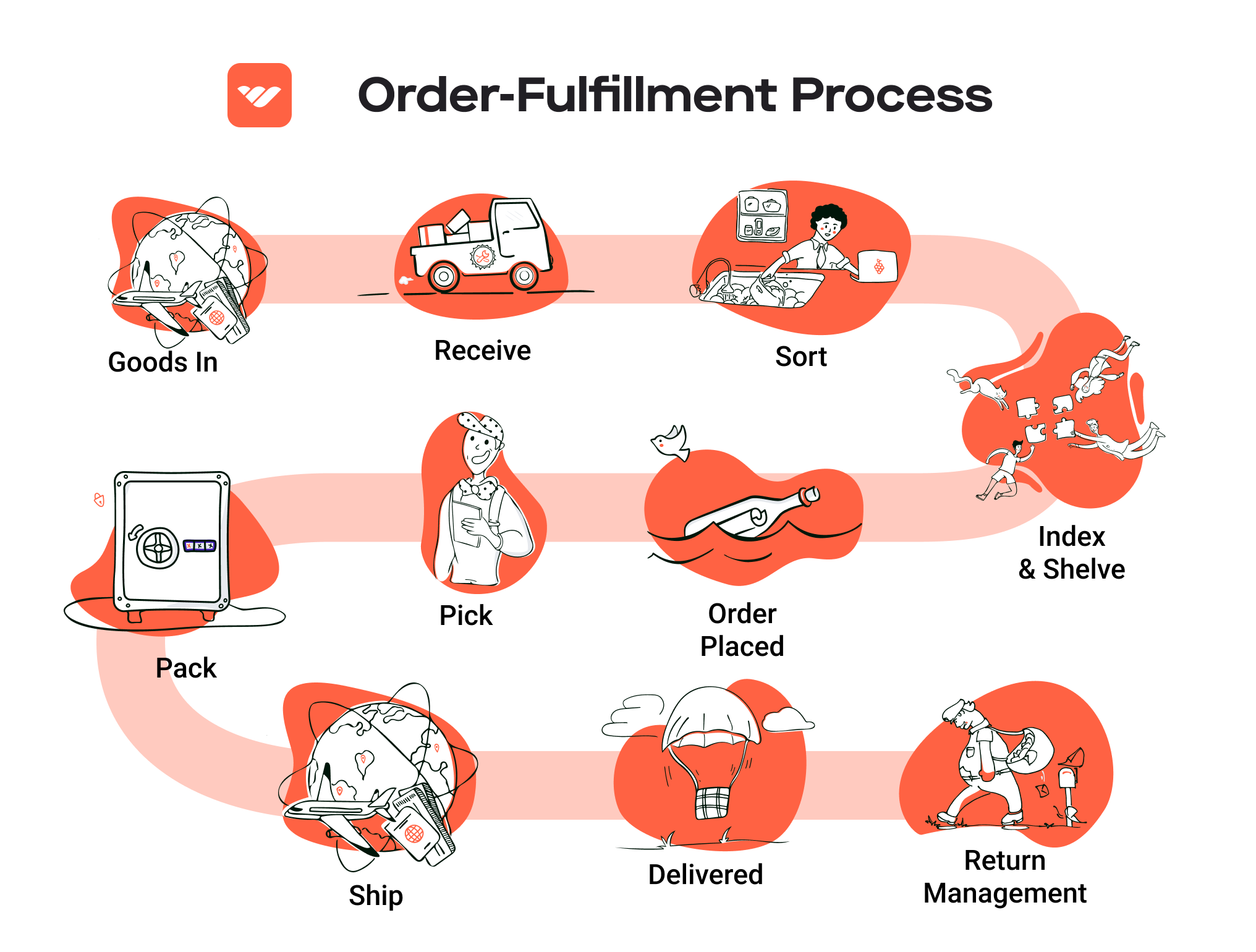
Customer Trust
Products fulfilled by Amazon carry a level of trust and assurance due to Amazon’s reputation for quality service. Customers know that they will receive their orders on time and that they have easy return options, which can boost conversion rates for sellers.
Multi-Channel Fulfillment
FBA is not limited to Amazon sales. Sellers can use FBA to fulfill orders from other sales channels, such as their own websites or other online marketplaces. This flexibility allows businesses to streamline their operations and manage inventory in one place.
Cons of Using FBA
High Fees
While FBA offers numerous advantages, it comes at a cost. Sellers must pay for storage and fulfillment fees, which can add up, especially for larger items or those that have low turnover rates. These fees may significantly impact profit margins, particularly for small businesses.
Strict Inventory Rules
Amazon has stringent guidelines regarding inventory management. Sellers must adhere to specific packaging and labeling requirements, and failure to comply can result in additional fees or penalties. Additionally, long-term storage fees apply for items that remain in a fulfillment center for over a specified period, which can further erode profitability.
Commingling Risks
FBA uses a commingling system where inventory from different sellers is stored together. While this can simplify logistics, it also poses a risk. If a customer returns a product, it may be difficult for Amazon to track which seller’s inventory the returned item belongs to. This can lead to complications, especially if customers return damaged or defective products that could affect a seller’s account standing.
Who is FBA Best For?
Fulfillment by Amazon is particularly beneficial for sellers who:
-
Have a High Volume of Sales: Businesses that experience steady sales can leverage FBA to scale quickly without the burden of managing logistics themselves.
-
Sell Consumer Products: Retailers selling consumer goods that are eligible for Prime shipping can see significant boosts in sales due to increased visibility and customer trust.
-
Are Looking to Expand: Sellers who want to reach a broader audience and expand their market presence can benefit from Amazon’s extensive customer base and marketing capabilities.
-
Prefer to Outsource Logistics: For entrepreneurs who wish to focus on product development, marketing, and customer engagement rather than warehousing and shipping, FBA provides an efficient solution.
-
Sell Seasonal Items: Businesses with seasonal products can take advantage of FBA’s scalability without the need for long-term storage commitments.
Conclusion
Fulfillment by Amazon presents an attractive solution for many e-commerce businesses looking to streamline their operations and enhance their customer service. While it offers notable advantages like Prime eligibility, customer trust, and multi-channel fulfillment, sellers must also consider the associated fees, strict inventory rules, and potential commingling risks. By weighing these factors, businesses can determine whether FBA aligns with their operational strategy and growth goals, ultimately enabling them to scale effectively in a competitive marketplace.
Core Services Offered by Fulfillment Centers
Inventory Management & Warehousing
Inventory management and warehousing form the backbone of any effective fulfillment operation. Fulfillment centers specialize in maintaining optimal stock levels, which is crucial for e-commerce businesses to meet customer demand without overstocking, which can tie up capital.
In a typical fulfillment center, inventory is received, stored, and tracked using sophisticated software systems. These systems utilize barcoding and RFID technology to ensure real-time visibility of stock levels. This allows businesses to monitor their inventory across multiple locations and make informed decisions regarding restocking and order fulfillment.
Benefits:
1. Efficiency: Automated inventory management reduces the likelihood of human error, ensuring that stock levels are accurate and up-to-date.
2. Cost Savings: By maintaining optimal inventory levels, businesses can minimize storage costs and avoid losses from unsold stock.
3. Scalability: As e-commerce businesses grow, fulfillment centers can quickly adapt to increasing inventory demands without the need for businesses to invest in their own warehousing solutions.
Pick and Pack Services
Pick and pack services are essential for the order fulfillment process. This service involves selecting the right items from the warehouse (picking) and preparing them for shipment (packing). Fulfillment centers employ advanced technology and skilled labor to streamline this process, ensuring that orders are fulfilled accurately and efficiently.
The picking process can be enhanced through automation, where robots assist in retrieving items from storage. After items are picked, they are packed with care to ensure they arrive at the customer’s doorstep in perfect condition. This includes choosing the right box size, packing materials, and labeling.
Benefits:
1. Speed: Automated systems and trained staff significantly reduce the time it takes to fulfill an order, leading to faster delivery times.
2. Accuracy: Advanced picking technologies and processes minimize picking errors, which improves customer satisfaction and reduces return rates.
3. Flexibility: Fulfillment centers can handle a variety of order sizes and complexities, allowing businesses to offer customized packaging options and special requests.
Kitting and Assembly
Kitting and assembly services are particularly beneficial for e-commerce businesses that sell products requiring combination or assembly before shipping. A fulfillment center can bundle individual items into a single kit (kitting) or assemble products to meet specific customer orders. This service is ideal for businesses offering gift sets, subscription boxes, or customizable product options.
Kitting services involve gathering various items, packaging them together, and preparing them for sale as a single unit. On the other hand, assembly services involve constructing or assembling products from multiple components.
Benefits:
1. Value Addition: By offering kitted products, businesses can enhance their product offerings, creating unique value propositions that can increase sales.
2. Time Savings: Outsourcing kitting and assembly allows businesses to focus on core activities like marketing and customer engagement while the fulfillment center manages the labor-intensive assembly tasks.
3. Quality Control: Fulfillment centers typically have quality checks in place to ensure that assembled products meet specified standards before they are shipped, reducing the risk of customer dissatisfaction.
Returns Management (Reverse Logistics)
Returns management, or reverse logistics, is a critical service provided by fulfillment centers that can significantly impact customer satisfaction and operational efficiency. This service involves handling returned products, processing them, and determining their next steps, whether that be restocking, refurbishment, or disposal.
An effective returns management system is vital for e-commerce businesses, as it directly affects customer loyalty and retention. Fulfillment centers often provide easy return processes, including return shipping labels and tracking, which simplifies the experience for customers.
Benefits:
1. Enhanced Customer Experience: Efficient returns processing can lead to higher customer satisfaction, as customers appreciate hassle-free return options.
2. Cost Management: Fulfillment centers can analyze return data to identify trends and underlying issues, helping businesses reduce return rates and associated costs.
3. Inventory Recovery: Through effective returns management, fulfillment centers can quickly assess returned items and reintegrate them into inventory, ensuring that products are available for resale as soon as possible.
By leveraging these core services offered by fulfillment centers, e-commerce businesses can streamline their operations, improve customer satisfaction, and ultimately scale their operations efficiently.
How to Choose a Fulfillment Partner: A 6-Point Checklist
Location & Warehouse Network
Importance: The geographical location of your fulfillment partner’s warehouses can significantly impact shipping times and costs. A partner with strategically located warehouses can help you reach your customers faster and reduce shipping expenses.
Questions to Ask:
– Where are your warehouses located, and how do they align with my target market?
– What is your average shipping time to key regions?
– Do you have warehouses in multiple countries, and how does that affect international shipping?
Technology & Integrations
Importance: In today’s fast-paced e-commerce environment, technology plays a crucial role in streamlining operations. A fulfillment partner with advanced technology can offer real-time inventory tracking, order management, and seamless integration with your existing systems.
Questions to Ask:
– What technology platforms do you use for inventory management and order processing?
– Can your systems integrate with my e-commerce platform (e.g., Shopify, WooCommerce, Amazon)?
– Do you provide real-time data and analytics on order status and inventory levels?
Specializations (e.g., cold storage, oversized items)
Importance: Depending on your product type, you may need a fulfillment partner with specialized services. For example, if you sell perishables, you’ll need a partner with cold storage capabilities. Similarly, if you deal with oversized items, ensure the partner can handle them efficiently.
Questions to Ask:
– Do you have specialized facilities for handling specific product types, such as food or oversized items?
– What measures do you have in place to ensure product safety and compliance with industry regulations?
– Can you accommodate unique packaging requirements for my products?
Scalability & Capacity
Importance: As your business grows, your fulfillment needs will change. Choosing a partner that can scale with you is essential to avoid disruptions in service during peak seasons or when launching new products.
Questions to Ask:
– How do you handle seasonal fluctuations in order volume?
– What is your current capacity, and how quickly can you scale operations if needed?
– Do you have contingency plans in place for unexpected spikes in demand?
Pricing and Contracts
Importance: Understanding the cost structure is vital to ensure you remain profitable. Different partners offer various pricing models, including per-order fees, storage fees, and additional charges for services like packing and shipping.
Questions to Ask:
– Can you provide a detailed breakdown of your pricing structure?
– Are there any hidden fees I should be aware of, such as for returns or special handling?
– What are the terms of your contracts, and is there flexibility for renegotiation as my business evolves?
Customer Support & Reviews
Importance: Reliable customer support is essential for resolving issues quickly and maintaining a smooth operation. Additionally, researching reviews and testimonials can provide insight into the partner’s reliability and service quality.
Questions to Ask:
– What type of customer support do you offer (e.g., phone, email, chat), and what are your hours of operation?
– How quickly do you typically respond to inquiries or issues?
– Can you provide references or case studies from businesses similar to mine?
Conclusion
Choosing the right fulfillment partner is a critical decision that can significantly impact your e-commerce business’s efficiency and customer satisfaction. By using this checklist, you can systematically evaluate potential partners based on key operational factors that align with your business goals. Remember, a successful partnership should not only meet your current needs but also adapt as your business grows and evolves. By asking the right questions and considering these essential criteria, you can find a fulfillment partner that supports your path to scaling your operations effectively.
Understanding Fulfillment Pricing: A Breakdown of Common Fees
Initial Setup Fees
When starting to use a fulfillment center, businesses often encounter initial setup fees. These fees can vary widely depending on the fulfillment provider and the services offered. Initial setup typically includes costs associated with creating an account, integrating inventory management systems, and possibly customizing the warehouse for specific business needs.
Most providers will charge a one-time fee that may range from a few hundred to several thousand dollars, depending on the complexity of the setup. This fee often covers the onboarding process, including training and support to ensure a smooth transition into the fulfillment ecosystem. Businesses should inquire about any additional costs that might arise during the setup phase, such as software integration or specialized training.
Receiving Fees
Receiving fees are charged when inventory is delivered to the fulfillment center. This fee covers the labor and resources needed to unload, inspect, and input inventory into the system. Typically, receiving fees are calculated based on the volume of products received, often charged per pallet or per unit.
For instance, a fulfillment center may charge a flat fee per pallet received or a variable fee based on the total number of items. It’s important to note that some providers may have minimum fees, meaning even small shipments could incur a standard charge. Businesses should factor in these costs when planning inventory shipments to avoid unexpected expenses.
Storage Fees (per pallet/bin)
Storage fees are recurring charges applied to the inventory stored in the fulfillment center. These fees are typically calculated based on the space utilized, either per pallet or per bin. For example, a fulfillment center may charge a monthly fee for each pallet stored, which can vary based on the size of the pallet and the duration of storage.
Most providers use a tiered pricing model where the cost per pallet decreases as the number of pallets stored increases. Additionally, businesses should be aware of potential long-term storage fees, which may apply if inventory remains unsold for an extended period, typically over six months. Understanding these charges is crucial for managing cash flow and inventory turnover effectively.
Pick & Pack Fees (per item/order)
Pick and pack fees are charged for the labor involved in retrieving items from storage and preparing them for shipment. This fee is usually calculated per item picked or per order processed. For example, a fulfillment center may charge a set fee for the first item in an order and a reduced fee for each additional item.
The pick and pack process involves several steps: locating the item, packing it securely, and labeling it for shipment. Some fulfillment centers offer different levels of service, such as customized packaging or gift wrapping, which may incur additional fees. Businesses should evaluate their product types and order volumes to determine the most cost-effective fulfillment model.
Shipping Fees
Shipping fees cover the cost of transporting packages from the fulfillment center to the end customer. These fees can vary significantly based on several factors, including the shipping method chosen (standard, expedited, etc.), the destination of the package, and the size and weight of the shipment.
Fulfillment centers typically have relationships with multiple carriers, allowing them to offer competitive rates. Businesses should consider the balance between shipping costs and delivery speed to optimize customer satisfaction. Additionally, many fulfillment centers provide tools to estimate shipping costs based on order size and destination, which can aid in budgeting.
Tips for Getting an Accurate Quote
To obtain an accurate quote from a fulfillment center, businesses should take the following steps:
-
Clearly Define Your Needs: Provide detailed information about your product types, expected order volumes, and any special requirements (e.g., kitting, custom packaging) to ensure the quote reflects your business model accurately.
-
Request a Breakdown of Fees: Ask for a detailed breakdown of all potential fees, including setup, receiving, storage, pick and pack, and shipping. This transparency will help identify any hidden costs.
-
Compare Multiple Providers: Gather quotes from several fulfillment centers to compare pricing structures and service offerings. This will help you identify the best fit for your business needs.
-
Inquire About Discounts: Ask about volume discounts or promotional pricing for new clients. Some fulfillment centers may offer reduced rates for higher order volumes or long-term contracts.
-
Review Terms and Conditions: Carefully read the terms and conditions associated with the quote to understand any potential changes in pricing based on specific circumstances or changes in your business operations.
By following these tips, businesses can ensure they select a fulfillment partner that meets their operational needs while remaining cost-effective.
Frequently Asked Questions (FAQs) about Fulfillment
1. What is the DCA1 Amazon Fulfillment Center?
The DCA1 Amazon Fulfillment Center is one of Amazon’s key logistics hubs located in Sparrows Point, Maryland. It plays a crucial role in processing and fulfilling customer orders for a wide range of products sold on the Amazon platform. This facility handles inventory receiving, storage, order picking, packing, and shipping, ensuring timely delivery to customers.
2. What services does DCA1 provide for sellers?
DCA1 offers services under the Fulfillment by Amazon (FBA) program, allowing sellers to store their inventory in Amazon’s fulfillment centers. Amazon takes care of the entire order fulfillment process, including picking, packing, shipping, and handling customer service, enabling sellers to focus on growing their business.
3. How does the fulfillment process work at DCA1?
The fulfillment process at DCA1 involves several key steps:
1. Inventory Receiving: Products are received and sorted.
2. Storage: Items are stored and tracked using barcode systems.
3. Order Processing: Orders are automatically processed when customers make purchases.
4. Order Picking: Items are picked using automated systems and human workers.
5. Packing: Orders are packed using optimized materials for efficiency.
6. Shipping: Packages are labeled and dispatched through various carriers for delivery.
4. What’s the difference between a warehouse and a fulfillment center?
A warehouse primarily serves as a storage space for goods, focusing on inventory management. In contrast, a fulfillment center is designed specifically for order processing and logistics, involving picking, packing, and shipping products directly to customers. Fulfillment centers often utilize technology and automation to streamline these processes.
5. What is a 3PL, and how does it relate to fulfillment centers?
A Third-Party Logistics (3PL) provider is a company that offers outsourced logistics services, including warehousing, fulfillment, and transportation. Many businesses partner with 3PLs to leverage their expertise and infrastructure for order fulfillment, similar to how sellers utilize Amazon’s fulfillment centers like DCA1.
6. How much do fulfillment services cost at DCA1?
Fulfillment costs at DCA1 vary based on several factors, including storage fees, picking and packing fees, and shipping costs. Sellers enrolled in the FBA program pay fees based on the size and weight of their products, as well as any additional services they may require. It’s advisable for sellers to review Amazon’s fee structure for precise calculations.
7. How can I track my inventory at the DCA1 Fulfillment Center?
Sellers can track their inventory using Amazon Seller Central, where they can view real-time data regarding stock levels, order statuses, and fulfillment metrics. This platform provides insights into inventory performance and alerts for low stock levels.
8. What shipping options are available through DCA1?
DCA1 offers a range of shipping options tailored to meet different delivery timelines, including standard, expedited, and same-day shipping for eligible Prime orders. Amazon utilizes a diversified fleet, including trucks, vans, and even drones, to optimize delivery speed and efficiency.
9. How does DCA1 handle returns?
Returns processed at DCA1 follow Amazon’s streamlined return policy. Customers can initiate returns through their Amazon accounts, and the fulfillment center manages the return logistics, including receiving returned items, inspecting them, and updating inventory records accordingly.
10. Can I use DCA1 without being a part of Amazon’s FBA program?
No, DCA1 is specifically designed for sellers who are part of the Fulfillment by Amazon (FBA) program. To utilize the services of this fulfillment center, sellers must enroll in FBA, allowing them to take advantage of Amazon’s extensive logistics network and customer service capabilities.
Conclusion: Is Outsourcing Fulfillment the Right Move for Your Business?
Evaluating the Benefits of Outsourcing Fulfillment
Outsourcing fulfillment can be a game-changer for e-commerce businesses aiming to scale efficiently and effectively. One of the most significant advantages is the time savings that come from delegating complex logistics tasks to a specialized partner. By choosing a fulfillment service, you can redirect your focus towards strategic growth initiatives such as product development, marketing, and customer engagement, rather than getting bogged down in daily shipping operations.
Scalability is another critical benefit. As your business grows, so does the complexity of your fulfillment needs. A reliable fulfillment partner can seamlessly adjust to fluctuations in order volume, ensuring that your business can handle peak seasons without compromising service quality. This adaptability not only enhances operational efficiency but also helps maintain high customer satisfaction levels.
Moreover, outsourcing fulfillment grants you access to a wealth of expertise and technology that may be costly or impractical to implement in-house. Fulfillment centers, especially those like Amazon’s, utilize advanced automation and logistics strategies that streamline the entire process from order receiving to shipping. This level of sophistication can significantly improve accuracy and speed, allowing you to meet customer expectations consistently.
However, it’s crucial to select the right fulfillment partner to align with your business goals and values. A poor choice can lead to disruptions and customer dissatisfaction, which can be detrimental to your brand.
To determine if outsourcing fulfillment is the right next step for your business, conduct a thorough audit of your current shipping processes. Evaluate your operational bottlenecks, cost efficiency, and capacity for growth. This assessment will provide valuable insights and help you make an informed decision that aligns with your long-term vision. Take action today to position your business for scalable success.
Important Disclaimer
⚠️ Important Disclaimer
The information in this guide is for educational purposes. Fulfillment services, pricing, and platform features change frequently. Always conduct your own due diligence and consult with providers directly before making business decisions.
